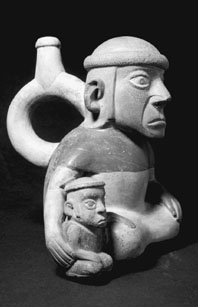

 | Page 897 |  |
large pyramid sites of huaca del sol and Huaca de la Luna. During the course of Moche history, a distinctive pottery style developed, one that emphasized accurate observation of everyday life. Moche culture was also rich in other areas of the decorative arts.

A typical Mochica pottery effigy jar picturing a mother and child
(Burstein Collection/Corbis)
Uncertainty still surrounds the political organization of the Moche culture, which appears to have been based around social stratification. The erection of large pyramids, first at Huaca del Sol and later at Galindo and Pampa Grande, indicates that although the core territory of the Moche culture may have retreated from the coast in the early seventh century a.d., some continuity in forms of political organization may have continued. The cause of the downfall of the Moche is also widely debated. It has been argued that adverse weather patterns generated by the El Niño current attacked the fundamentals of the Moche economy; other people have suggested that Moche was adversely affected by the rise of the Huari state. Whatever the reason or reasons, it is clear that the Moche culture had been influenced by the earlier Chavín cultural forms and that it in turn influenced the Chimú and other cultures that followed it.
See also
References
Donnan C.B. 1976. Moche Art and Iconography. Los Angeles: Latin American Center, University of California–Los Angeles.
See Indus Civilization; South Asia
A major site and center of Zapotec civilization in southern mexico, Monte Albán is a huge hilltop site adjacent to the modern city of Oaxaca. Monte Albán is located in the center of the three major arms of the Valley of Oaxaca and is surrounded by rugged mountains. The Zapotecs are members of an ethnic group that is still widespread in Oaxaca today, and there is no doubt that their ancestors built Monte Albán.
Prior to 500 b.c., the Valley of Oaxaca had seen a long period of cultural development that had given rise to a number of chiefdoms, each containing a central town with several hundred inhabitants and public ceremonial buildings surrounded by smaller agricultural villages. The settlement and demography of the valley changed radically in 500 b.c., however. Monte Albán was founded on top of a 400-meter-high hill on what had previously been bare land. The hill was leveled, and settlement began in three discrete localities on the hilltop. From this fact some scholars have argued that Monte Albán represents the coming together in a central place by the people of the three arms of the valley, and certainly, the valley and its preexisting towns and villages saw a temporary reduction in population after the founding of Monte Albán.
Over the following centuries, Monte Albán grew enormously in population and power, and it came to dominate the entire Valley of Oaxaca as well as lands beyond. There are some indications
 |  |